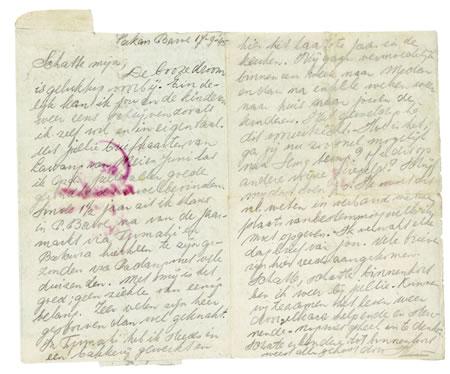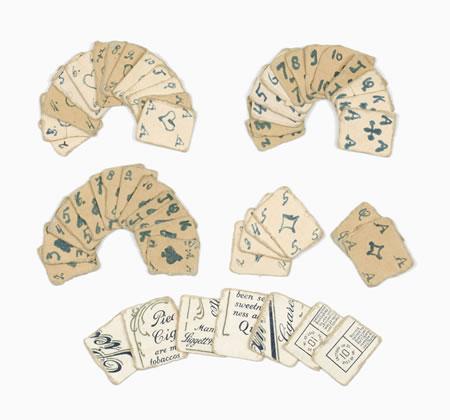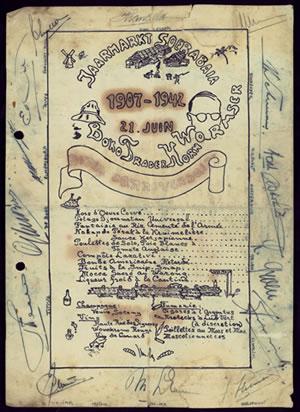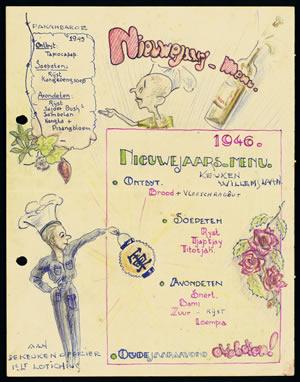Allies in adversity, Australia and the Dutch in the Pacific War: The van Gelder family
Herman and Rosaline van Gelder and their children Max (aged 11), Hans (10), and Carla (7) were living at Semarang, on the island of Java, when the war began. As a result of his service in the local Stadswacht, or home guard, Herman van Gelder was made a prisoner of war immediately after the Japanese arrived. The other members of the family were soon evicted from their house, which was commandeered by a Japanese officer; they eventually made their way to the home of Rosaline’s mother in the village of Lawang, in the hills south of Surabaya.
At this time, Max, as the oldest and largest child, was put to work by the Japanese in a vitamin factory, while Hans, who was smaller and in poor health, remained hidden. Despite suffering many hardships, the family avoided internment for the remainder of the war. After the Japanese surrender, however, Max was imprisoned by Indonesian nationalists in a camp for men, while Rosaline, Hans, and Carla were all placed in the “Women’s Camp”. While the others were eventually released, Max and the older men endured a year’s incarceration before they were given their freedom. In 1946, Max was reunited with his family, including Herman, who had been imprisoned in camps at Surabaya and later at Padang and Pakan Baroe on the island of Sumatra. Miraculously, all the van Gelders survived the war.

The first letter sent by Herman van Gelder to his wife Rosaline after his release from Pakan Baroe in September 1945, this British army airmail reads as follows:
My Darling
The bad dream has fortunately passed. Finally it is possible for me to write to you and the children in our own language. Your postcards from Lawang, in May and June, tell me that you are all well. For a year and a half, I have been at Pakan Baroe, after the Jaarmarkt, via Tjimahi and Batavia. We were sent here via Padang , with very many thousands of others. All is well with me. No illnesses of any importance or concern. Very many have perished, and many more have been broken. In Tjimahi, I have worked constantly in a bakery, and here, during the past year, in the kitchen. Most probably, we will be going to Medan within a week, and then in a few more weeks, home to you and the children. It is an incredible feeling to look forward to. How are things with you, and how quickly can you get to Semarang? Or have different arrangements been made? Please write to me and let me know, as I need to be able to nominate my final destination. I expect a letter from you any day. Many letters from various relatives have already arrived in the camp.
Dear, not long until I will be back with you all, and we can pick up our lives again, help and assist each other and support one another. It’s an incredible thought, and I can’t quite get my mind around it.
Darling and children, until then, stay healthy …
Wait! I have discovered that there is a back page to fill up yet. The women here have had a very bad time. They were in Benkoelen. Janette has lost so much weight she looks like a lamp post. I have not put on much weight myself, but I am healthy. It’s only my eyes which have suffered considerably, but this will be able to be rectified by a proper diet and glasses, so you needn’t worry about it at all. How is the children’s schooling? They most likely got well behind, but that, too, can be rectified. Have you been able to keep them up to date?
Embrace and kisses,
your husband
Herman
The van Gelder children: Hans (left), Carla and Max at Semarang in 1941, a few months before the Japanese invasion.
The reunited van Gelder family in 1946: (left to right) Carla, Hans, Rosaline, Max and Herman.

Herman van Gelder was a lifelong bridge enthusiast and during his captivity in the Jaarmarkt camp at Surabaya, he made a small pack of playing cards from a torn-up cigarette packet. Though crude, the cards were a treasured possession, and remained in use until malnutrition caused Herman’s eyesight to deteriorate, preventing him from playing.

While in captivity, Herman van Gelder made this bracelet as a token of affection for his wife. Manufactured from scraps of aircraft perspex and small brass crown and eagle insignia (probably from RAF or RAAF uniform), Herman hid the bracelet, carrying it about with him, until he was finally reunited with Rosaline in 1945.
-
Stool mp3
- 2:27
-
Stool mp3
- / 2:27
This folding stool was made by Max van Gelder as a gift for his mother, Rosaline. While held by Indonesian nationalists in the “Men’s Camp” in 1945, Max learned that his mother was spending much of her time in the “Women’s Camp” queuing for essential items. Max describes how he took a teak panel from one of the doors in the camp and fashioned it into a stool which was smuggled into the camp for her.

This menu for an anniversary dinner at the Jaarmarkt camp, Surabaya, in June 1942 was signed by many prisoners of war (including, at top, Herman van Gelder).

Another menu, this time for a dinner at Willemslaan after Herman van Gelder’s release from captivity, contrasts the diet of 1945 with that of the New Year, 1946. RC03443.004–008

